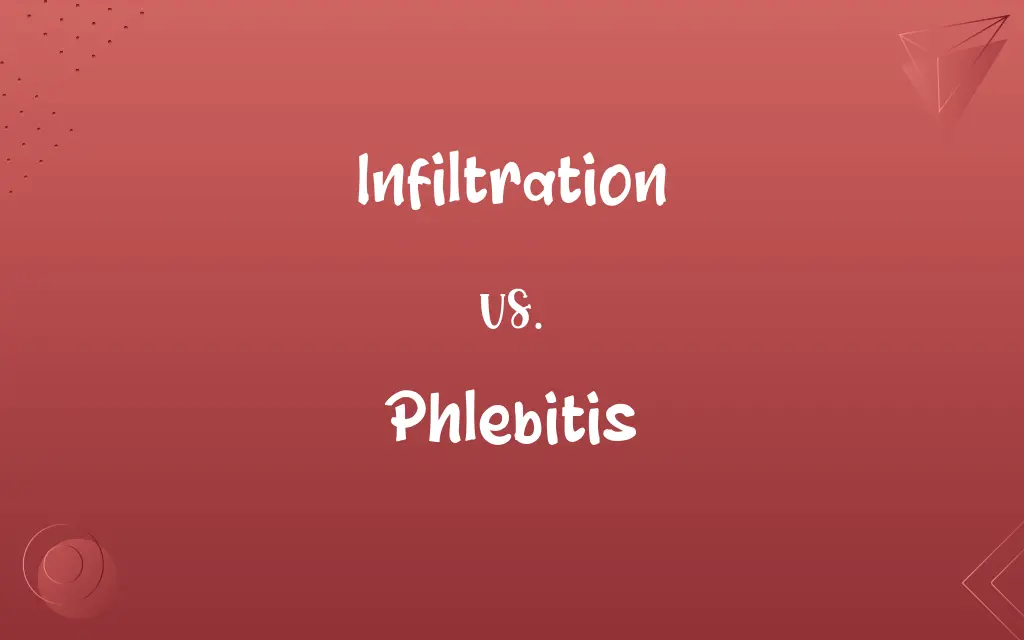Infiltration vs. Phlebitis: Know the Difference

By Shumaila Saeed || Updated on February 24, 2024
Infiltration is when IV fluid or meds leak into tissue instead of the vein. Phlebitis is vein inflammation, often from an IV, due to mechanical, chemical, or bacterial causes.

Key Differences
Infiltration caused when the needle or catheter dislodges from the vein, allowing the IV fluid to leak into the surrounding tissue. This can happen due to improper insertion, movement of the patient or the catheter, or the vein's inability to sustain the flow rate. While Phlebitis results from irritation to the vein's lining. Mechanical phlebitis can occur due to the physical presence of the catheter, chemical phlebitis from the medication or solution being infused, and bacterial phlebitis from infection at the catheter site.
Shumaila Saeed
Feb 24, 2024
Infiltration characterized by swelling, discomfort, tightness, and coolness of the skin around the IV site. The area may also appear pale and be tender to touch. Phlebitis resents with redness, warmth, tenderness, and swelling along the path of the vein used for the IV. Patients may also experience pain or burning sensations.
Shumaila Saeed
Feb 24, 2024
Infiltration treatment involves stopping the infusion, removing the catheter, elevating the affected limb, and applying warm or cold compresses depending on the type of fluid infiltrated. Monitoring and supporting the affected area to reduce swelling and discomfort are also important. Managing phlebitis includes removing the IV catheter, applying warm compresses to reduce inflammation, and possibly administering anti-inflammatory medications. If bacterial infection is present, antibiotics may be required.
Shumaila Saeed
Feb 24, 2024
Preventive measures for both conditions focus on meticulous technique during catheter insertion, careful site selection, and regular assessment of the IV site for signs of complications. For infiltration, securing the catheter properly and educating the patient on avoiding movements that could displace the IV can significantly reduce risks. In preventing phlebitis, using the smallest possible catheter, changing IV sites as recommended, and employing sterile techniques are key strategies. Additionally, minimizing the duration of IV catheter placement can help prevent both infiltration and phlebitis.
Shumaila Saeed
Feb 24, 2024
Understanding the differences between infiltration and phlebitis is crucial for healthcare professionals to ensure effective IV therapy and minimize patient discomfort. While both conditions require immediate attention and appropriate intervention, their distinct causes and symptoms necessitate tailored approaches to treatment and prevention. By recognizing the early signs of each and implementing preventive measures, healthcare providers can significantly improve patient outcomes and reduce the incidence of these IV-related complications.
Shumaila Saeed
Feb 24, 2024
ADVERTISEMENT
Comparison Chart
Definition
Occurs when IV fluid or medication leaks into the surrounding tissue.
Inflammation of a vein, often at an IV site.
Shumaila Saeed
Feb 24, 2024
Causes
Improper catheter placement, dislodgement, or vein rupture.
Mechanical irritation from the catheter, chemical irritation from the fluid, or bacterial infection.
Shumaila Saeed
Feb 24, 2024
Symptoms
Swelling, discomfort, coolness, and pallor at the IV site.
Redness, warmth, tenderness, swelling, and possibly a burning sensation along the vein.
Shumaila Saeed
Feb 24, 2024
Treatment
Stopping the infusion, removing the catheter, elevating the limb, applying warm or cold compresses.
Removing the catheter, applying warm compresses, administering anti-inflammatories or antibiotics if infected.
Shumaila Saeed
Feb 24, 2024
Prevention
Careful catheter insertion and securement, regular monitoring of the IV site.
Using the smallest necessary catheter, changing IV sites regularly, sterile technique upon insertion.
Shumaila Saeed
Feb 24, 2024
ADVERTISEMENT
Complications
Tissue damage, potential for compartment syndrome in severe cases.
Thrombophlebitis (clot formation), progression to systemic infection.
Shumaila Saeed
Feb 24, 2024
Risk Factors
High flow rates, irritating solutions, poor vein selection.
Prolonged catheter use, catheter size, type of solution infused.
Shumaila Saeed
Feb 24, 2024
Management Focus
Limiting tissue damage and promoting recovery of the affected area.
Reducing inflammation, preventing infection, and restoring vein health.
Shumaila Saeed
Feb 24, 2024
Patient Education
Importance of reporting pain or changes at the IV site immediately.
Recognizing signs of phlebitis and the importance of maintaining IV site hygiene.
Shumaila Saeed
Feb 24, 2024
Healthcare Provider Actions
Regular assessment of IV sites, prompt response to signs of infiltration.
Diligent monitoring for signs of phlebitis, adherence to best practices in IV care.
Shumaila Saeed
Feb 24, 2024
ADVERTISEMENT
Infiltration and Phlebitis Definitions
Infiltration
IV insertion complication.
Immediate removal of the IV catheter is required upon detection of infiltration to prevent further tissue damage.
Shumaila Saeed
Feb 24, 2024
Phlebitis
Inflamed vein condition.
The red streak running along the vein's path was a classic symptom of phlebitis.
Shumaila Saeed
Feb 24, 2024
Infiltration
The act or process of infiltrating, as of water into a porous substance, or of a fluid into the cells of an organ or part of the body.
Shumaila Saeed
Oct 19, 2023
Phlebitis
Warm compress remedy.
Applying warm compresses helped reduce the discomfort caused by phlebitis at the IV site.
Shumaila Saeed
Feb 24, 2024
Infiltration
Tissue swelling from IV.
The patient's discomfort and the swollen area around the IV site were clear indicators of infiltration.
Shumaila Saeed
Feb 24, 2024
Phlebitis
Sign of IV site infection.
The warmth and redness around the catheter insertion site suggested the onset of phlebitis.
Shumaila Saeed
Feb 24, 2024
Infiltration
The act or process of infiltrating, as of water into a porous substance, of a fluid into the cells of an organ or part of the body, or of persons into a hostile organization.
Shumaila Saeed
Oct 19, 2023
Infiltration
Fluid leakage into tissue.
Noticing the IV site was swollen and cool to the touch, the nurse recognized signs of infiltration.
Shumaila Saeed
Feb 24, 2024
Phlebitis
Catheter-induced vein irritation.
Due to the patient's phlebitis, the medical team decided to relocate the IV catheter to a different vein.
Shumaila Saeed
Feb 24, 2024
Infiltration
Cold compress treatment.
To ease the infiltration symptoms, the nurse applied a cold compress to the affected area.
Shumaila Saeed
Feb 24, 2024
Phlebitis
Antibiotic treatment for infection.
To combat the bacterial phlebitis, the doctor prescribed a course of antibiotics.
Shumaila Saeed
Feb 24, 2024
Infiltration
The substance which has entered the pores or cavities of a body.
Calcareous infiltrations filling the cavities.
Shumaila Saeed
Oct 19, 2023
Infiltration
A process in which individuals (or small groups) penetrate an area (especially the military penetration of enemy positions without detection)
Shumaila Saeed
Oct 19, 2023
Infiltration
The slow passage of a liquid through a filtering medium;
The percolation of rainwater through the soil
The infiltration of seawater through the lava
Shumaila Saeed
Oct 19, 2023
Infiltration
Non-vein fluid accumulation.
Infiltration led to a noticeable puffiness around the patient's IV site, signaling the need for medical intervention.
Shumaila Saeed
Feb 24, 2024
Infiltration
The substance which has entered the pores or cavities of a body.
Shumaila Saeed
Oct 19, 2023
Infiltration
The act of secretly entering a physical location and/or organization.
Shumaila Saeed
Oct 19, 2023
Repeatedly Asked Queries
What is infiltration in the context of IV therapy?
Infiltration occurs when IV fluid or medication leaks outside the vein into the surrounding tissue, often recognized by swelling, discomfort, and coolness at the IV site.
Shumaila Saeed
Feb 24, 2024
How is phlebitis different from infiltration?
Phlebitis is the inflammation of a vein caused by irritation from an IV catheter, chemical irritation from the infused solution, or bacterial infection, characterized by redness, warmth, and tenderness along the vein.
Shumaila Saeed
Feb 24, 2024
What immediate actions should be taken if infiltration is suspected?
If infiltration is suspected, the IV should be stopped immediately, the catheter removed, the affected limb elevated, and warm or cold compresses applied based on the type of fluid infiltrated.
Shumaila Saeed
Feb 24, 2024
What are the common causes of infiltration?
Common causes include improper catheter placement, dislodgement of the catheter, or the vein's inability to sustain the infusion, often due to high flow rates or irritating solutions.
Shumaila Saeed
Feb 24, 2024
Are there any specific signs that distinguish phlebitis from other IV complications?
Yes, phlebitis is specifically characterized by redness, warmth, and tenderness along the vein, often with visible swelling and possibly a palpable cord along the vein.
Shumaila Saeed
Feb 24, 2024
What role does patient movement play in the occurrence of infiltration?
Excessive movement can dislodge the catheter or cause the vein to rupture, leading to infiltration; hence, securing the IV site and educating the patient on minimizing movement can help prevent it.
Shumaila Saeed
Feb 24, 2024
How does the choice of IV fluid or medication affect the risk of phlebitis?
Certain medications and solutions are more irritating to the vein's lining, increasing the risk of chemical phlebitis; hence, selecting less irritating alternatives or diluting solutions when possible can reduce this risk.
Shumaila Saeed
Feb 24, 2024
What preventive measures can reduce the risk of phlebitis?
Preventive measures include using the smallest possible catheter, changing IV sites regularly, ensuring sterile technique upon insertion, and minimizing catheter movement.
Shumaila Saeed
Feb 24, 2024
Can both infiltration and phlebitis be prevented by the same measures?
While some preventive measures overlap, such as careful catheter selection and secure placement, specific strategies like regular site rotation and gentle handling are more targeted towards preventing phlebitis, whereas ensuring correct catheter placement and monitoring infusion rates are crucial for preventing infiltration.
Shumaila Saeed
Feb 24, 2024
How can phlebitis be treated?
Treatment for phlebitis includes removing the IV catheter, applying warm compresses to reduce inflammation, and administering anti-inflammatory medications or antibiotics in cases of bacterial infection.
Shumaila Saeed
Feb 24, 2024
What is the importance of patient education in preventing IV therapy complications?
Educating patients about the importance of reporting pain, discomfort, or changes at the IV site can lead to early detection and treatment of complications like infiltration and phlebitis.
Shumaila Saeed
Feb 24, 2024
Can infiltration lead to long-term complications?
While most cases of infiltration resolve with minimal intervention, severe infiltration can lead to tissue damage, with extreme cases resulting in compartment syndrome requiring emergency treatment.
Shumaila Saeed
Feb 24, 2024
How often should an IV site be checked for signs of phlebitis or infiltration?
IV sites should be checked regularly, at least once every shift or according to the healthcare facility's protocol, to promptly identify and address any signs of complications.
Shumaila Saeed
Feb 24, 2024
What should be done if traditional treatments for infiltration or phlebitis do not alleviate the symptoms?
If symptoms persist or worsen, it may indicate a more severe issue, such as infection or tissue damage, requiring further medical evaluation and potentially more aggressive treatment.
Shumaila Saeed
Feb 24, 2024
What are the treatment options if both infiltration and phlebitis occur simultaneously?
Treatment involves addressing both conditions: removing the IV catheter, applying appropriate compresses (warm for phlebitis, cold or warm for infiltration depending on the solution), elevating the limb, and monitoring closely for infection.
Shumaila Saeed
Feb 24, 2024
Share this page
Link for your blog / website
HTML
Link to share via messenger
About Author
Written by
Shumaila SaeedShumaila Saeed, an expert content creator with 6 years of experience, specializes in distilling complex topics into easily digestible comparisons, shining a light on the nuances that both inform and educate readers with clarity and accuracy.








































































